Last Chance to Catch NYC's Holiday Notalgia Train
We met the voices of the NYC subway on our nostalgia ride this weekend!


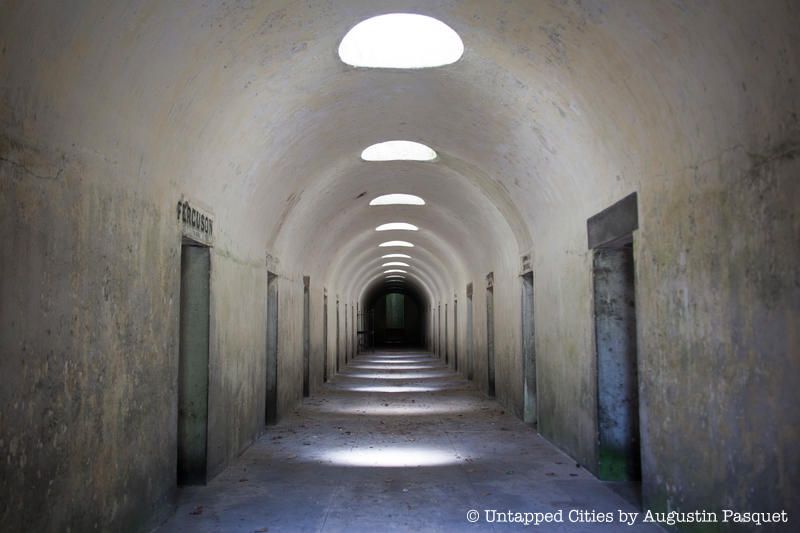
Green-Wood Cemetery was the second most popular tourist site in New York state by 1860, with over 500,000 visitors each year — Niagara Falls was the first. Located in Brooklyn near Prospect Park, the cemetery was founded in 1838 as one of the country’s first rural cemeteries. With over 560,000 “permanent residents,” many of whom are pretty famous, Green-Wood Cemetery has developed a reputation for being one of the most prestigious burial grounds in New York City. Its rolling landscape also helped inspire the creation of public parks in the city, including Central Park and Prospect Park. Without further delay, here are our top 10 secrets of Green-Wood Cemetery, a National Historic Landmark.
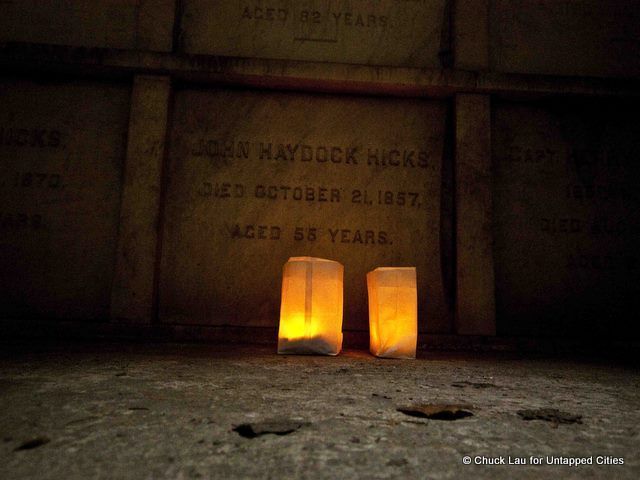
The catacombs of the Green-Wood Cemetery are opened only a few times a year to the public, for guided tours of the mysterious underground and for concerts. Access is gained by using an old-fashioned dungeon-like key, which unlocks the iron gates out front. The staff of Green-Wood cemetery calls the space “30 Vaults,” a reference to the number of vaults inside.
Located underneath a hill stretching about 150 feet, the catacombs date to the early 1850s, built as a series of family vaults in an area that was once excavated for gravel. The most famous person buried in the catacombs part of Green-Wood cemetery is Ward McAllister, the Gilded Age high society tastemaker who coined the term “The 400” to refer to the exclusive set in New York City that could fit in Mrs. Astor’s ballroom. He was not as wealthy as those he advised, so burial in the Green-Wood catacombs was a fitting endeavor for someone of his stature. Richman says McAllister would have been “quite chagrined to know that the catacombs are now locked up and access is very limited.”
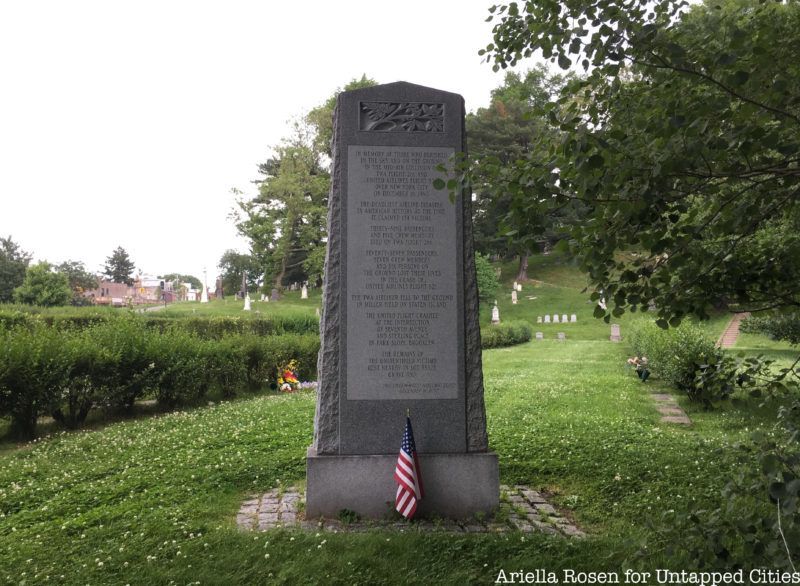
On December 16, 1960, Trans World Airlines Flight 266 and United Airlines Flight 826 collided over Staten Island. While the TWA flight crashed on Staten Island, the United Airlines plane unsuccessfully attempted to reach LaGuardia Airport only to crash in Park Slope, Brooklyn. The Park Slope plane crash set fire to 10 brownstones at the intersection of Sterling Place and Seventh Avenue, along with three other stores, and a church (ironically named the Pillar of Fire Church).
In Park Slope, 84 people on the flight were killed, along with six people on the ground. The TWA crash on Staten Island killed 44 passengers and crew members. In an effort to figure out why the crash occurred, this investigation was the first to use a plane’s black box data recorder. Since DNA identification was not yet possible, the remains at the Park Slope crash were placed into three caskets labeled “Fragmentary Human Remains” and buried in unmarked grave lot number 38325, purchased by United Airlines. On December 16, 2010, on the 50th anniversary of this gruesome event, Green-Wood Cemetery dedicated a proper memorial for the victims who perished.
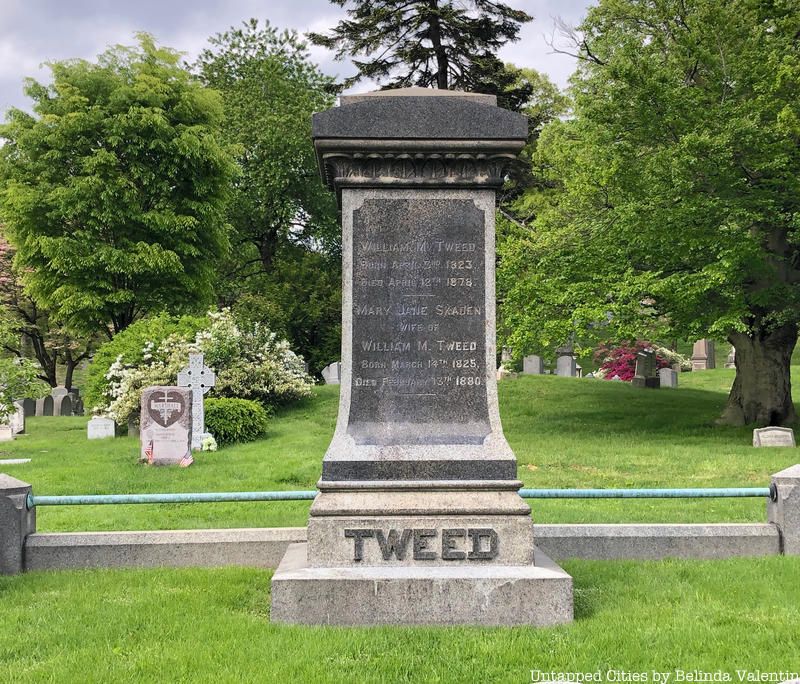
Until 1848, Green-Wood Cemetery was the fourth most popular place to be buried in the United States. Among the many immigrants and ordinary citizens interred there are members of prominent New York families like the Roosevelts, Pierreponts, Jeromes, and Schermerhorns.
There are also many famous residents buried there including William Meager “Boss” Tweed, the infamous corrupt politician; Henry Chadwick, the “Father of Baseball”; Horace Greeley, founder and editor of the New York Tribune; Leonard Bernstein, notable American composer and conductor; artist Jean-Michel Basquiat; Frank Morgan Wupperman, the actor who played the wizard in The Wizard Of Oz: and Samuel Morse, the inventor of the telegraph. Among these famous individuals also lie 5,000 Civil War soldiers, a large percentage of who were laid to rest in unmarked graves.
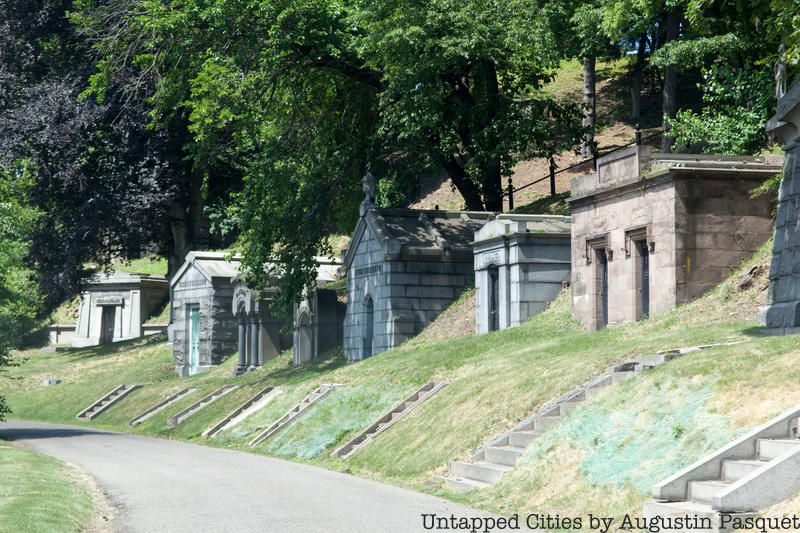
In January 2013, while a construction worker was working on an expansion of the Crematory and Columbarium, he discovered a small metal box buried in a wall. It turned out to be a time capsule from 1954 containing six, 19th-century published books on the Green-Wood Cemetery. Some titles include “A Handbook for Green-Wood” (1867) and “Green-Wood Illustrated” (1847), both written by Nehemiah Cleaveland, the cemetery’s first historian.
Despite being wrapped in plastic, the books suffered severe water damage, leaving the pages to turn into pulp. Retired Professor Anthony Cucchiara of Brooklyn College, an expert in dealing with water-damaged artifacts, was involved in the restoration process, ordering the books to be frozen to prevent any further damage. After freezing, the titles became visible, but the overall conditions were beyond salvaging. The good news is though, those same titles are not entirely out of print as copies are part of Green-Woods’ collection.
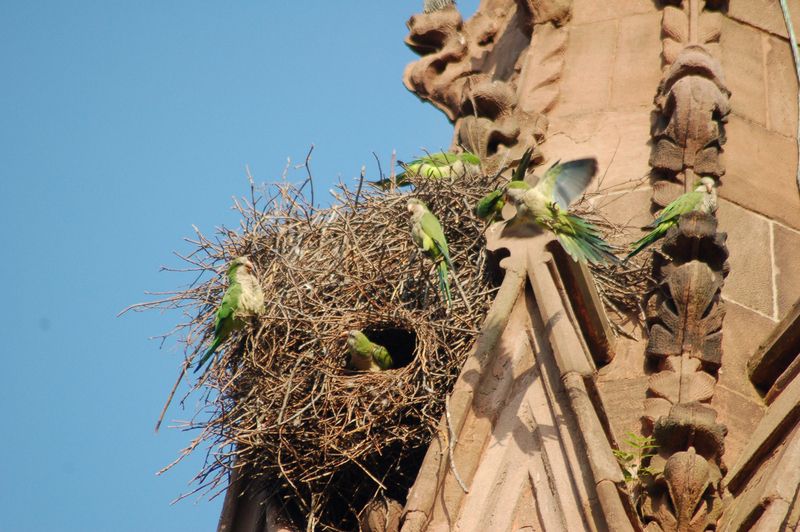
Image from Brooklyn Parrots
Since the 1970s, Green-Wood Cemetery has had a group of interesting (though quite possibly illegal) tenants, Argentinian Monk parrots (Myiopsitta monachus). Details behind how exactly the parrots got there are a bit fuzzy, but there are some interesting theories. The most popular version claims that in 1967, an unmarked crate made its way to JFK Airport where a curious worker opened it, letting free a small flock of monk parrots. A similar version of the story claims that the “curious airport employee” was actually an individual with ties to the mafia looking to profit from the crate’s contents.
While many exotic parrots have escaped into the city, the monk parrots seem to be the only ones able to survive the harsh winters. The birds made their way into residential areas, where they naturally started to annoy residents, who then naturally reported it to the authorities. Authorities not knowing what to do were told by the Argentinian government that killing them would be the easiest way to get rid of them. In 1973, a group of bird hunters hired by the US government chased the flock, killing only about half. The rest flew off to Rikers Island. The bird hunters chased them there but had to wait a day for permits to enter the premises. By the time they got there, the parrots had flown away, seeking refuge in Green-Wood Cemetery where they continue to live. Steve Baldwin of Brooklyn Parrots hosts “safaris” bringing interested visitors to the cemetery to see and learn more about New York City’s colorful, and loud residents.

Although the cemetery was never affiliated with a specific church, it strives to remain non-sectarian. The cemetery was generally seen as a Christian burial place for white Anglo-Saxon Protestants of higher social standing although the cemetery was never affiliated with a specific church. With the large number of people buried here, you wouldn’t think there would be certain criteria a dead person would have to meet in order to be allowed to rest there. One of its main regulations is that nobody who was executed for a crime, or died while incarcerated was allowed to be buried here.
Boss Tweed, however, was an exception. After he died at the Ludlow Street Prison, he was able to get around this rule. While Boss Tweed was buried in Green-Wood Cemetery, the mayor of the time, Mayor Smith Ely, refused to fly the flag at half-staff, not considering Boss Tweed worthy of the honor. As The New York Times reported in 1866, “It is the ambition of the New Yorker to live upon Fifth Avenue, take his airings in the [Central] Park and to sleep with his fathers in Green-Wood.”
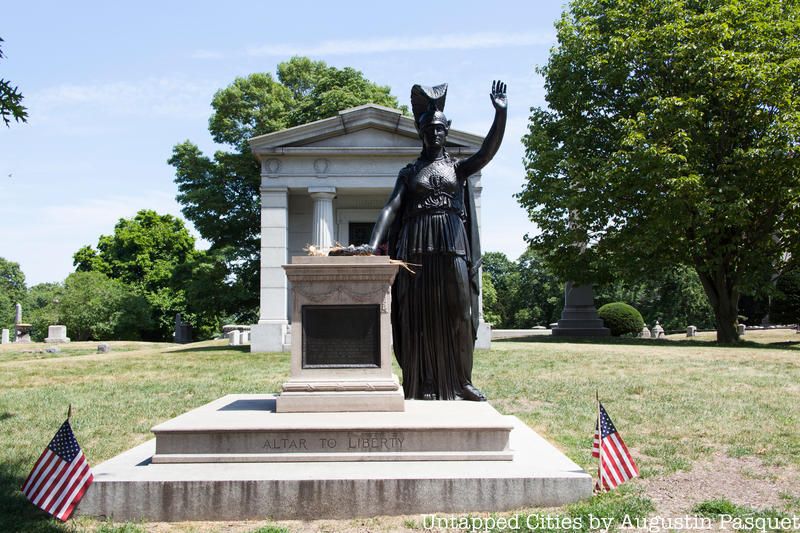
In the days of the Revolutionary War, the area that Green-Wood Cemetery now occupies was the site of a major battle in 1776: The Battle of Brooklyn, also known as the Battle of Long Island. The first major battle fought after the signing of the Declaration of Independence, this area was strategically important in defending New York.
After a successful attempt to drive the Continental Army out of Manhattan, the British forced the Patriots to retreat to Brooklyn Heights. On August 27, 1776, in an attempt to capture Brooklyn Heights, the British attacked American pickets defending the local Red Lion Inn, commencing the Battle of Brooklyn. However, not to be defeated or slaughtered on the battlefield, Brigadier General Williams Alexander Sterling and the Delaware Regiment made a fighting retreat, and against all odds made it safely across Gowanus Creek with only 2 men killed and 24 missing. The Altar to Liberty in Green-Wood, located at the highest point in Brooklyn, the top of Battle Hill, is dedicated to the Battle of Brooklyn. The monument is the Roman goddess Minerva laying a wreath on top of an altar. Additionally, each year, Green-Wood holds a reenactment of the Battle Brooklyn, honoring the cemetery’s historic past.
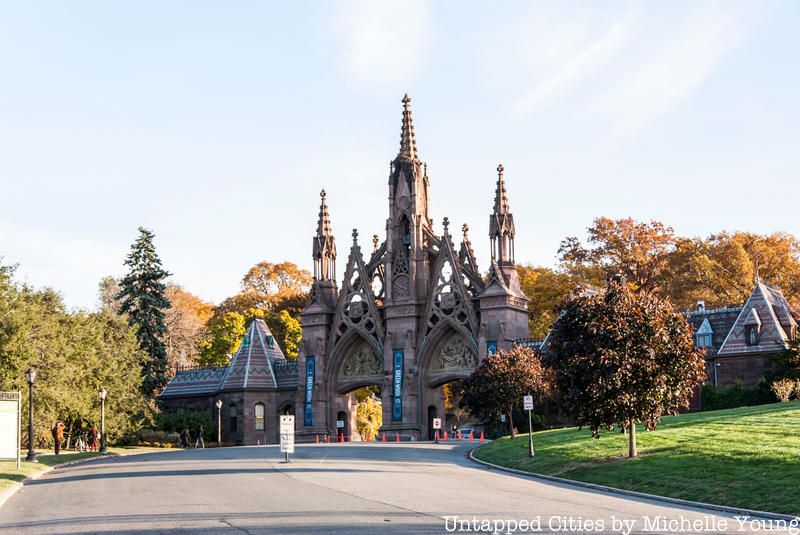
Designed in the late Revival Gothic style by Richard Upjohn and his son Richard M. Upjohn, the Brownstone Gate’s arches were built between 1861 and 1863 during the Civil War. Richard Senior is remembered for designing Trinity Church on Wall Street, as well as being the first president of the American Institution of Architects. Richard Junior is interred at Green-Wood.
Made of Brownstone, this gate combines three pinnacle towers and two pointed-arch entrances. Decorated with Gothic tracery and sandstone reliefs depicting biblical and allegorical scenes, the entrance to the cemetery stands tall and strong. Finally, on either side of the arches are two pavilions for a visitors center and cemetery office.

Given the sheer amount of individuals interned at Green-Wood Cemetery and its almost 200-year history, the monuments, mausoleums, sculptures, and tombstones at Green-Wood represent a wide variety of architectural and artistic styles. Most mausoleums on site are built in the Classical style, featuring columns, but there is also a large number of Gothic-inspired mausoleums as well. Others resemble ornate, medieval chapels, and there are even Egyptian-inspired monuments, especially obelisks.
There are also many sculptures across the entire 478 acres, some part of specific tombs, others more decorative. One statue, in particular, sparked a controversy: Civic Virtue. Originally unveiled as part of a monumental fountain in City Hall Park in 1922, the sculpture group was intended to be an allegorical representation of Virtue triumphing over Treachery and Corruption. The problem was that Virtue (a man) was standing over and defeating Vice in the form of female mermaids, coming off as oppressive to women. The statue moved to Queens in 1941 only to be met with a new wave of feminists who took issue with it as well, ultimately leading the sculpture to be “banned” to Green-Wood on December 15, 2012.
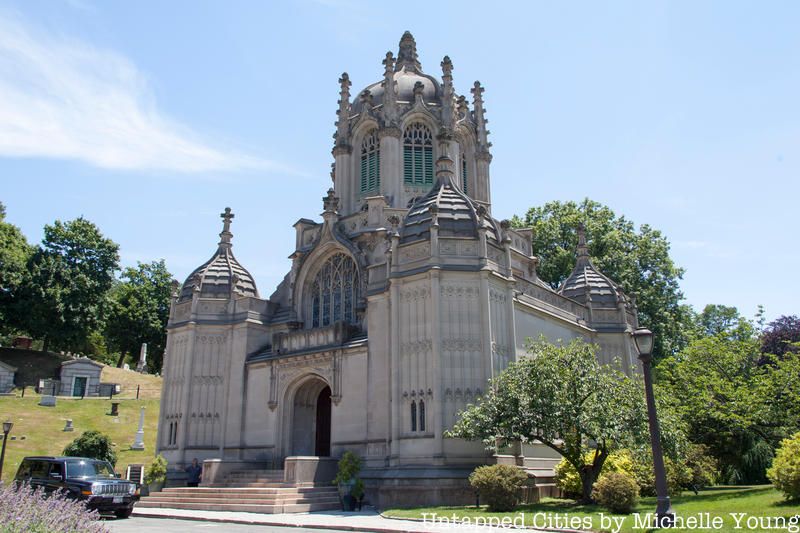
The architectural firm of Warren & Wetmore has left its mark across the city, designing some of the city’s most prominent buildings in the early 20th century, including Grand Central Terminal and Chelsea Piers. The Green-Wood Chapel stands alongside those famed buildings.
This Gothic Revival-style chapel was built in 1911 and designed by Warren & Wetmore. The chapel was inspired by the Tom Tower, a famous bell tower in Oxford, England characterized by an octagonal lantern and notable dorm. Inside, Green-Wood Cemetery’s chapel, there is a beautiful, large stained glass window, and a chandelier suspended under a rib-vaulted ceiling.
Next, check out 10 famous people buried in cemeteries across New York City!
Subscribe to our newsletter